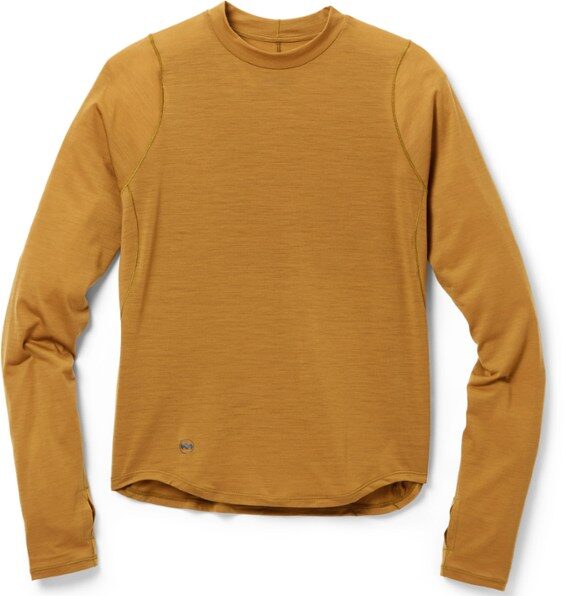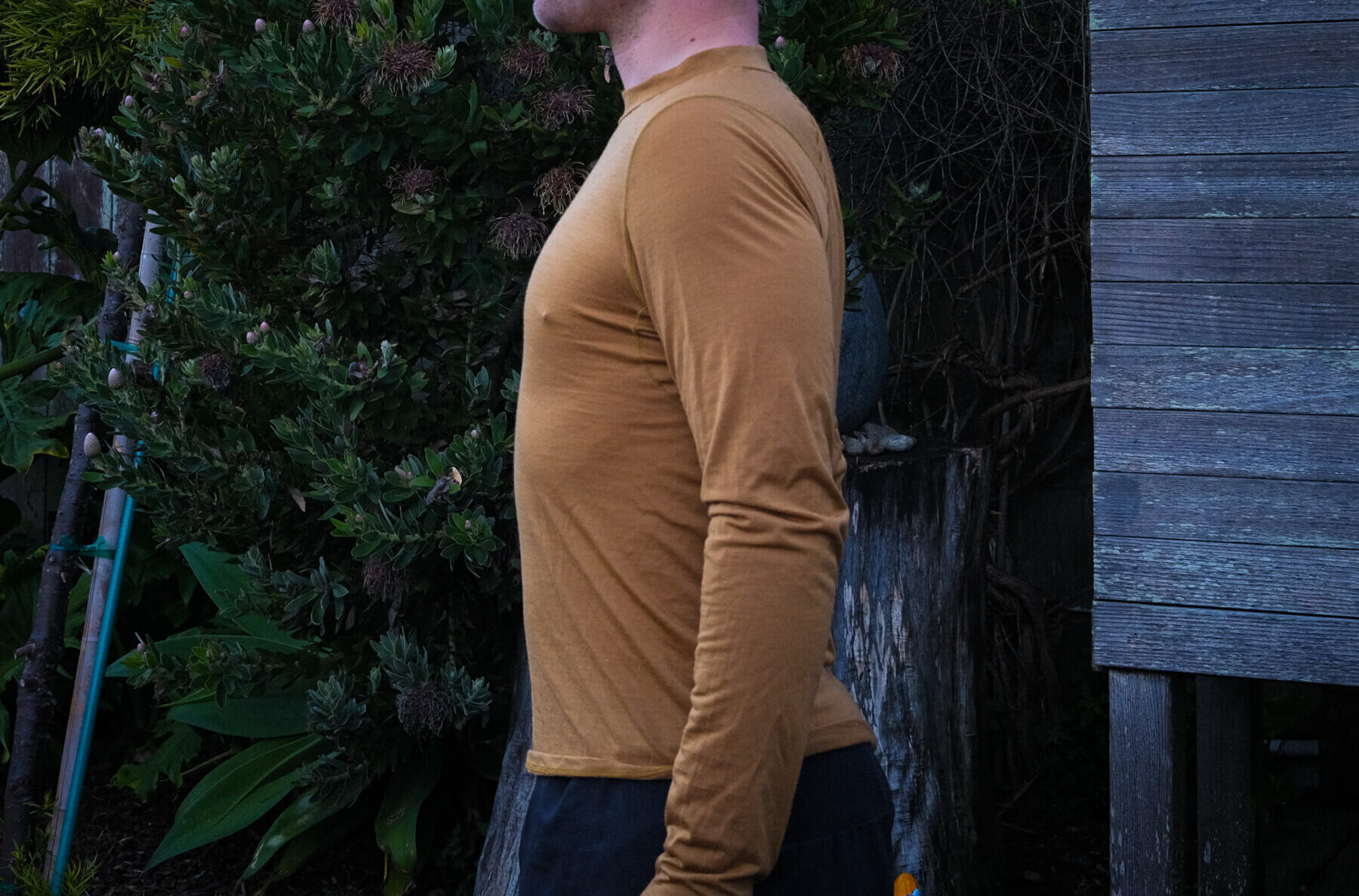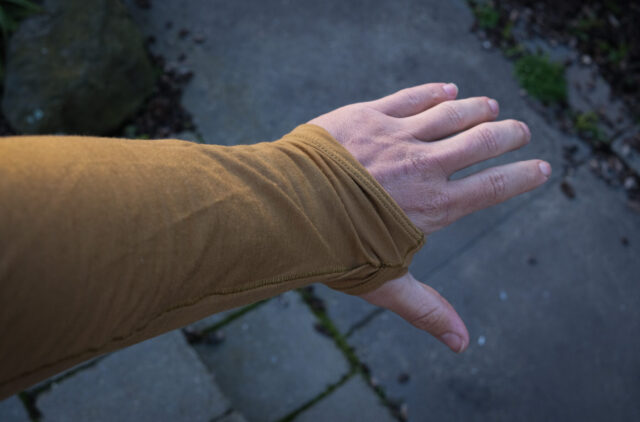Janji Repeat Merino Tech Long Sleeve
Test Duration: 110 miles
Test Locations: Marin, CA
Fabric: 47% 17.5μ merino wool, 38% 37.5 nylon, 15% nylon
Stated Features:
- “37.5 Technologies” nylon with volcanic ash enhances thermoregulation and anti-stink properties
- 17.5 micron merino for thermoregulation, odor-resistance, and comfort
- Thumb loops on sleeves
Stated Weight: 282 g / 9.9 oz (US Men’s Size M )
Blister’s Measured Weight: 135 g (US Men’s Size S)
MSRP: $88
Size Tested: US Men’s Size Small
Reviewer: 5’9”, 150 lbs / 175 cm, 68 kg

Intro
Layering for winter trail running can be tricky business. If not done right, dressing improperly for the weather has the potential to strip your run of its enjoyment, at the very least, and in some scenarios even threaten your safety. Unlike sports such as mountain biking and skiing that are a bit more amenable to stashing layers not in use, trail running tends toward minimalism, and while definitely part of its allure, this ethos can sometimes strand folks in situations they don’t have the necessary gear to contend with. Not to mention, running also happens to be one of the more perspiration-inducing forms of cardio out there, and as anyone who has spent significant amounts of time in the backcountry knows, sweat can be a killer in cold environments.
Regardless of what conditions you’re up against, the foundation of a successful layering system for cold weather running starts with what you choose to put against your skin. A common misconception around base layers is that they’re meant to keep you warm, when in fact their main function is to prevent you from getting cold. While most garments will have some insulation by virtue of the fabric they’re made from, a base layer’s true value lies in how well it stops sweat from evaporating from skin (our bodies’ natural cooling process we want to intentionally blunt in colder temps) and how well it promotes evaporation from its fabric (i.e., how quickly it rids itself of the sweat it takes from our skin, essentially).

Janji, the Boston-based apparel company known for its responsibly made running attire, recently introduced a winter performance layer into their line enhanced by “37.5 Technologies” nylon, an innovative type of fabric that uses volcanic ash to help with thermoregulation (i.e., the process of evaporation explained above). The new Repeat Merino Tech Long Sleeve tee claims multipurpose use as a base layer in cold conditions and a stand-alone top in warmer weather, all in a package made from a merino blend that’s purportedly “light-yet-might” and “odor resistant.” I’ve spent the past month clad in Janji’s Repeat Merino as often as possible, frequently wearing it on back-to-back (to back) runs amidst the chaotic spell of weather conditions that battered much of Northern California earlier this year. In this review, I’ll touch on the layer’s overall performance, speak to the efficacy of 37.5 Technologies nylon, discuss who should consider picking one up, as well as the role it should play in your wardrobe.
Fit
In order to thermoregulate well, base layers need to have a lot of skin contact, which means their fit should be predictably snug. If worn too baggy, moisture will begin to collect in common pooling areas under the arms and down the back / torso, undermining the evaporation process and keeping you wet. Successful base layers manage this without feeling too constricting. Knowing the importance of a snug fit, I went with a Men’s Size Small in the Repeat Merino, and I’m glad I did.
While by no means skin tight, the top hugged my chest and torso well before tapering ever so slightly by my waist; the stitching for each contoured sleeve begins a few inches above the shoulder and allowed for full range of motion during my arm swing (they’re also appropriate length that’s complemented by nifty thumb holes that disappear when not in use); the back panel is segmented in a way that increases mobility; and the mock neck is a nice touch in line with the shirt’s function as a colder weather layer that I felt brought a small helping of additional warmth when temps plummeted. The Repeat Merino is meant to be worn both as a foundational layer within a system of several and as a stand-alone piece, and I think Janji has balanced its fit to service both roles; it’s snug enough to easily accommodate a midlayer but free enough to function as a general long sleeve running shirt.

Construction
Merino has worked its way into becoming the material of choice for cold-weather running tops and there’s plenty of legitimacy behind its use. As a type of wool, merino is known to thermoregulate well, offer good breathability, and resist odor. The natural coils in its fibers hang onto pockets of air to provide insulation when it’s cold and evaporate perspiration effectively when it’s warm. Additionally, merino is thinner, softer, and less scratchy than standard wool, making it ideal for next-to-skin base layers. For the Repeat Merino, Janji uses an ultra-fine 17.5 micron merino blended with 37.5 Technologies nylon to produce a lightweight, breathable fabric that I found to feel more finely knit and therefore more comfortable than other wool-based layers I’ve worn in the past. This definitely reduced the temperature extremes I felt confident wearing the top in on its own though, likely eliminating it as an option for runs below 40 degrees Fahrenheit. However, the inverse was also true, as I had no issues with overheating when wearing the Repeat Merino when it was 65 degrees Fahrenheit and sunny out.

The Repeat Merino gets an additional temperature-regulating advantage from the 37.5 Technologies nylon. In short, 37.5 Technology is a patented fabric technology that attracts the water vapor from sweat away from skin and expedites evaporation from clothing at faster rates than traditional fabrics, so the brand claims. Materials treated with 37.5 Technology receive ultra-porous volcanic minerals and coconut-derived activated carbon that absorb some of the infrared energy emitted by our bodies, in turn initiating 37.5 Technology particles to speed up evaporation. The increased surface area fabrics treated with this application benefit from also supposedly expedites the removal of humidity. Despite sounding quite a bit like the product of science fiction, I do think that the Repeat Merino’s treated nylon did outperform many of the generic wool / nylon layers I have in my closet. While it by no means blew me away, and I’d stop short of calling it a “game-changer,” the top’s ability to move / remove moisture felt more effective than layers focused on sweat-wicking (i.e., dispersing moisture instead of actually eliminating it).
A couple of other things worth calling out in this section include the quality of the Repeat Merino’s seams, which are so far holding up to daily wear and the turbulence of the occasional trip through the washing machine, as well as the shirt’s interior neck locker loop, a small detail that’s made hang-drying it easy. Janji was started by members of a college cross country team and products designed like the Repeat Merino speak to the company’s understanding of what kinds of features runners want / need in their apparel.
On Trail
When it comes to running apparel, I tend to favor a minimalist approach. Once I’ve landed on a pair of shorts or a top that fits me particularly well, I’ll typically buy several of each, enough to get me through about a week’s worth of running before having to do a load of laundry. I’ll admit it, this means I’ll often wear clothing two or, on the rare occasion, three times before they see soap and water. Applaud me for being environmentally conscious if you’d like, but the truth of the matter is that I think any energy-saving effects of this habit are unintentional consequences of my general laziness. Nevertheless, Janji’s Repeat Merino, a layer designed to be worn multiple times in a variety of settings, seemed pretty attuned to my needs.
For those of you who live in areas with true winters, the temperatures I’m about to mention might seem balmy by your standards, but remember, “cold” is relative and I’m likely a lot softer than you. January and February in the Bay Area see morning lows in the 40°F’s that spike to highs in the 50°F’s to upper 60°F’s by noon (i.e., it heats up quick). That’s a significant swing, but neither end represents an extreme, and a smartly chosen single long-sleeve top generally suffices on dry, non-windy days. Temperatures also fluctuate wildly between the sun and shade as well as at different altitudes, with the most frigid areas represented by deep coastal valleys where pockets of cool air coagulate.


For those of you who live in areas with true winters, the temperatures I’m about to mention might seem balmy by your standards, but remember, “cold” is relative and I’m likely a lot softer than you. January and February in the Bay Area see morning lows in the 40°F’s that spike to highs in the 50°F’s to upper 60°F’s by noon (i.e., it heats up quick). That’s a significant swing, but neither end represents an extreme, and a smartly chosen single long-sleeve top generally suffices on dry, non-windy days. Temperatures also fluctuate wildly between the sun and shade as well as at different altitudes, with the most frigid areas represented by deep coastal valleys where pockets of cool air coagulate.
In a gentle coastal climate, the Repeat Merino thrived as a stand-alone layer. Its cut contributed to a fit that’s snug enough for the moisture-eliminating properties of its wool / 37.5 Technology nylon blend to work as they should, and its layout — especially the contoured shoulders and racerback back panel — helped to preserve mobility while on the move. I favored the top’s warmth-to-weight ratio on my longer runs that began in the dark and finished in glaring sunlight. The ultra-thin merino had just enough warmth to keep me from feeling completely miserable waiting around at trailhead parking lots; it did a proficient job of quickly filtering out moisture so that I didn’t immediately freeze up when I paused mid-run to wait for friends; and transitioned from being insulating to ventilating the moment I began to overheat.
Janji has a heavy environmental bent when it comes to their apparel, meaning that they use responsibly sourced material that’s intended to be durable for extended wear. Aside from its standout performance, this is another reason why I’ll likely add a few more Repeat Merinos to my rotation of running shirts. I purposely wore mine multiple runs in a row, which in hindsight could have spoiled a few friendships if the shirt’s wool / 37.5 Technology nylon blend didn’t do as good of a job fending off odor as it did. What was equally as impressive about wearing it repeatedly was its consistent comfort despite undergoing cycles of sweat. Unlike polyester-based tops I’ve worn multiple times that end up feeling starchy and salt-stained, the Repeat Merino kept its elasticity and softness. Granted, I’ve only worn the shirt routinely for about a month, so if anything changes I’ll make sure to chime back in with updates.
Who’s It For?
Is Janji’s Repeat Merino warm enough to hold its own against “real” winters with below-freezing temps? Probably not. Unless you use it as part of a more involved layering system, for which I think there are thicker base layer options out there that will keep you better insulated. That said, for folks who winter in more temperate regions like the Southwest and West Coast, this is a highly functional top to support comfortable running in climates with stark temperature swings, especially if you’re a heavy sweater. The Repeat Merino is also on my shortlist as a grab-and-go layer for travel; its odor-resistant and quick-drying properties support multiple wears if you’re on the road and strapped for space, and because it’s able to thermoregulate well in both cold and warm temperatures, it should be able to find some use wherever you go.
Bottom Line
The art of wintering layering for running is a skill often learned through patterns of mistakes. You’re just as likely to have an uncomfortable time out on the trails if you overdress or underdress, and threading the needle between takes an intuition gleaned from experience. Janji’s Repeat Merino Tech Long Sleeve, the brand’s new cold-weather performance staple, is designed to give you a bit more room for error when it comes to dressing for chilly runs. While there are likely better choices for when it’s truly freezing outside, the Repeat Merino excels as a lightweight, comfortable base layer and/or stand-alone top for mild winter conditions. Its merino wool / 37.5 Technology nylon blend thermoregulates more efficiently than many of the other materials we’ve tested, dries quickly, and resists odor, all attributes that allow for repeated wear in a broad range of use cases. If you live in a place where you can run year-round and you’re looking for a versatile long-sleeve shirt to get you through the winter, consider checking out Janji’s Repeat Merino.
